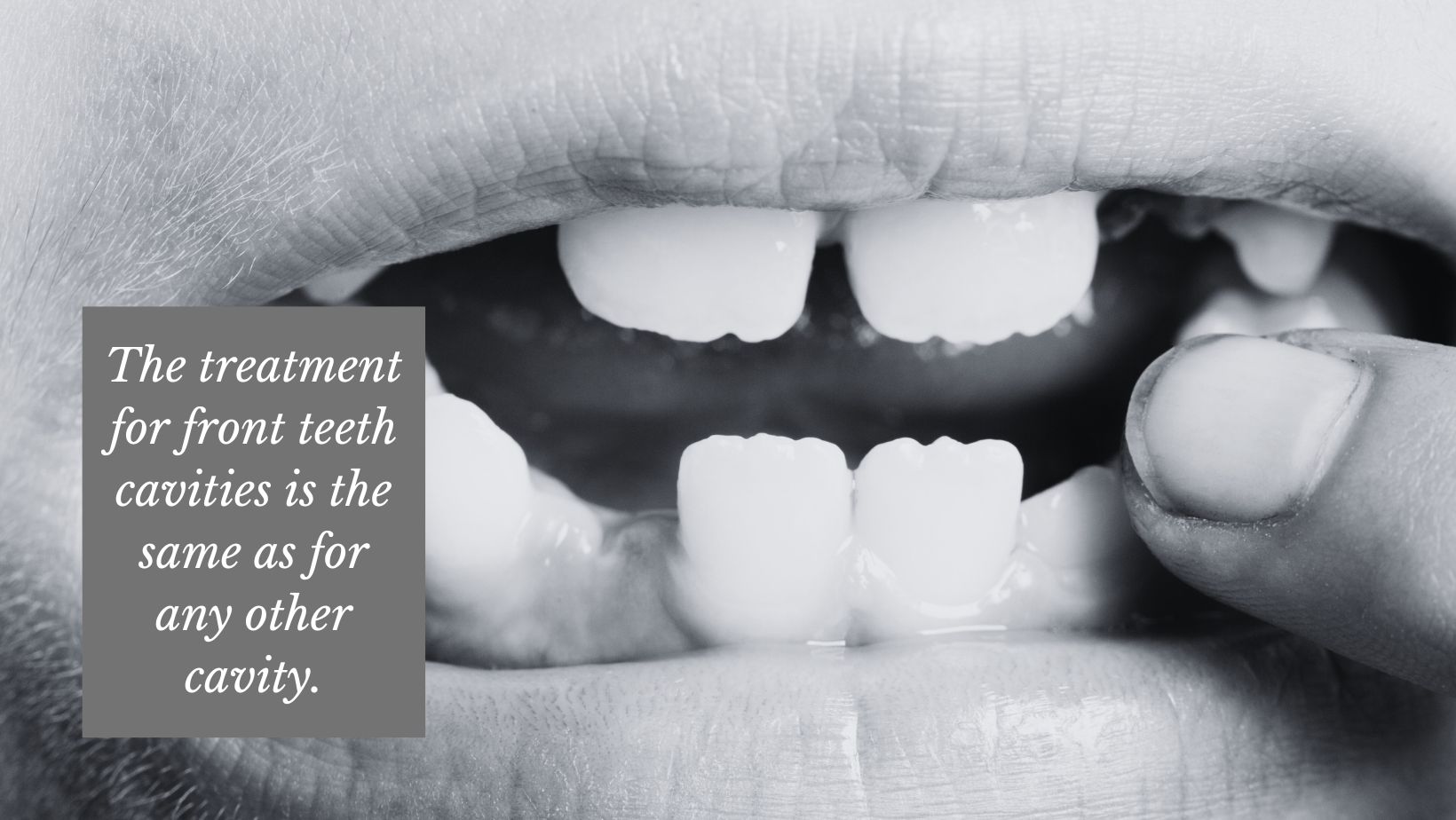This piece was originally published on September 21, 2020.
While they are not as common as cavities on back teeth, many patients are treated for cavities on front teeth.
Dentists repair cavities on front teeth the same as any other cavity. They may take some extra steps when fixing them, though, to make sure they look good. After all, these teeth are front and center for all to see. Some cavities on the front teeth can be treated with tooth-colored composite fillings. For larger fillings, a veneer that covers the entire front surface of the tooth is a better option. Finally, for extensive damage, the dentist may recommend a crown to fix decay and give the patient an attractive smile.
As with all cavity treatments, the best choice for fixing decay on front teeth is made by discussing your case with your dentist.
What Causes Tooth Decay on Front Teeth?
Most cavities occur in the molars and premolars, which are in the back of the mouth. Their rough surfaces make it easier for them to grind up food when chewing. The bumpy, uneven surface and deeper grooves are great places for food particles to stick. If those pieces of food don’t get cleaned away with brushing and flossing, their acids can eat away at teeth, causing cavities. On back teeth, it can be hard to reach some of these spots while brushing, making them prone to cavities.
Since front teeth, which are called incisors, are the easiest to reach and naturally smoother than back teeth, cleaning them is easier. This makes the formation of cavities on front teeth less likely, but they are still possible.
For adults, cavities in front teeth form in the same way as cavities in any other part of the mouth. They are usually caused by a combination of inadequate brushing and flossing and a diet full of sugary, acidic food and drink. Certain medical conditions, medications, and heredity can also play a part in a person’s chances of getting cavities. Finally, cavities on front teeth can be caused by teeth grinding (called bruxism) and trauma to the teeth from an injury.
In recent years, there has been an increase in cavities on front teeth among children and adolescents. As with adults, this rise is often attributed to the consumption of sugary beverages and snacks, poor oral hygiene habits, and inadequate exposure to fluoride.
When small children have severe cavities on their front teeth, it could be because of what is called “baby bottle tooth decay.” Most doctors ask parents to avoid letting their infants and toddlers have a bottle overnight or for long periods during the day. This can allow the natural sugars from milk, formula, or fruit juices to linger in the mouth. The result is bacteria that can cause cavities in baby teeth. Even though baby teeth eventually fall out, they are extremely important to a child’s dental development. Cavities at a young age can interfere with chewing and talking, and they can be painful.

Treating Cavities On Front Teeth
The treatment for front teeth cavities is the same as for any other cavity. Most often, that means a filling. Because of the location front and center in the mouth, the dentist will usually recommend porcelain or composite resin as the filling material. Unlike gold or silver-colored amalgam fillings, these materials can be made to match the color of the rest of the tooth.
Veneers are another treatment for repairing a cavity on a front tooth. Dentists often recommend veneers if a cavity is large and on the front-facing side of the tooth. A veneer covers up the entire front of the tooth and is a bit more invasive than a filling. For a filling, the dentist drills a hole right at the site of the cavity. For a veneer, they remove the decay and etch away a large portion of the enamel across the entire front surface of the tooth. The veneer is then cemented on to cover the tooth surface.
If tooth decay on front teeth is severe, the patient might need a dental crown to cover the entire tooth. If the cavity goes deep enough, they will probably need a root canal procedure first. Crowns, like fillings, also come in materials that can match the color, look, and feel of a natural tooth.
Any procedure that is done to fix a cavity on front teeth is usually done with cosmetics in mind. One thing to remember is that dental restorations are synthetic and not like real tooth enamel. Teeth get stained or discolored over time. But fillings, crowns, and veneers will stay the same, which can make them stand out, especially on front teeth. Likewise, they won’t change color, even with professional teeth whitening products. A good rule of thumb is to discuss future teeth whitening plans with the dentist. They can match the filling or crown to what the teeth will look like once they are the desired shade.
How Can I Tell If I Have a Cavity on a Front Tooth?
It is not always easy to know if you have a front tooth cavity that needs repair. When cavities are small, a patient may have no symptoms. Cavities on incisors may only show up with an x-ray at the dentist’s office. Sometimes, a cavity will be visible as a white spot or a dark shadow on the tooth, and these color changes can be easier to see with the naked eye on the front teeth.
As they grow, cavities are more likely to cause pain and discomfort. It may be hard to chew and hot or cold beverages might hurt.
The only way to be sure is to visit your dentist for a complete check up.
How to Prevent Cavities on Front Teeth
There are several steps patients can take to prevent the formation of decay on front teeth in the first place. These include:
- Getting regular dental cleanings and checkups. In addition to cleaning away cavity-causing plaque, dentists can often spot signs of early decay and offer treatments that do not require a filling.
- Limiting sugary and acidic food and drink that can contribute to decay.
- Brushing with a fluoride toothpaste and flossing between all teeth, every day. Good oral hygiene is the first defense against cavities.
Don’t Ignore a Cavity on a Front Tooth
Cavities in front teeth are no more—and no less—serious than any other cavity. But ignoring them can cause further damage as the decay spreads. No matter where a cavity is, see a dentist right away to get it fixed.
If you don’t have a regular dentist, use our online tool to find one.


